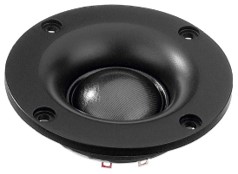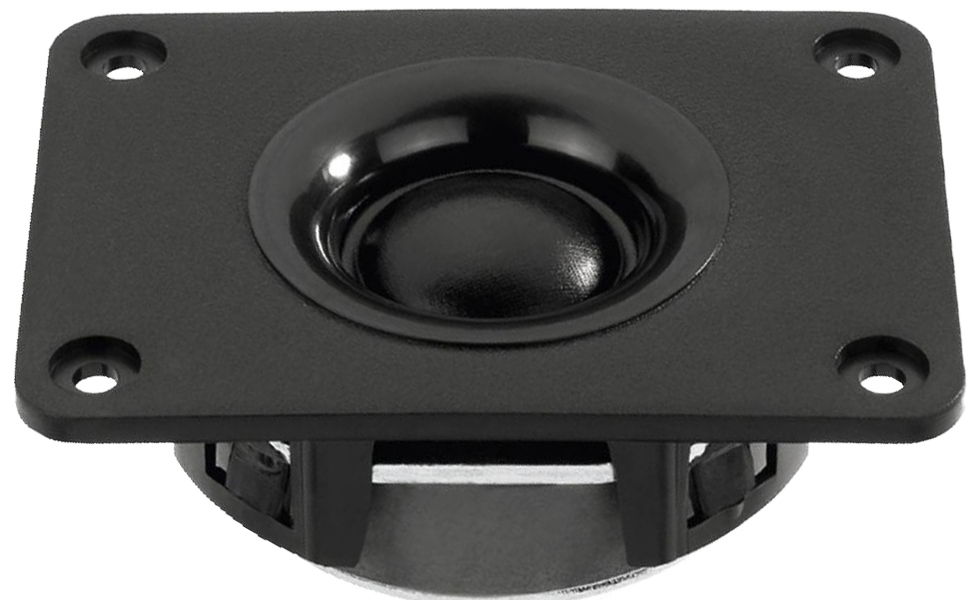"Wave guiding" your favorite tweeter.
As you might have noticed, our assortment has grown exponentially in the last couple of years. Two of the most recent additions are Visaton and Monacor. Both are well-known speaker manufacturers with a large range of products and roots as far back as the 1970s.
While adding their products to our webshop, I noticed that they both offer a waveguide designed for particular tweeters. Visaton offers the WG 148 R and the WG 200x150, both the same waveguide with a different mounting shape made to fit the G 25 FFL or the KE 25 SC. Monacor offers only a round waveguide; the WG-300, designed to be used with the DT-300 tweeter. Now, this is cool and all, but what if those tweeters are not your preferred tweeters? What if you wanted to mount another tweeter to one of those waveguides?
So, I decided to take matters into my own hands and went on a voyage to our warehouse, scanning for tweeters that might fit the waveguides and test fitting all of them. The opening of the waveguide was 38 mm in diameter, so while test fitting the tweeters, I decided to categorize them based on a couple of requirements.
1. Waveguide vs. Horn: A comparison
Before diving into my findings I think I should clarify something: What makes a waveguide a waveguide, and why is it not called horn, they look the same right? A very common question and one that is both very complicated and simple at the same time. To put it shortly, all horns are waveguides, but not all waveguides are horns. And this is where the complicated part comes in. By surrounding a transducer with a solid object you force (or guide) the soundwaves into a certain direction (with the exception of bass frequencies of course) causing a so-called pattern control a.k.a. directivity control. Therefore any object can act as a waveguide, but of course not every object will have desirable outcomes. Based on the rate at which the waveguide expands, it will start acting as a horn, adding gain to certain frequencies but also distortion to some degree. This is what separates a favourably shaped piece of plastic from an actual horn, let alone a very well-designed horn (one with little of the typical drawbacks of a horn).
Now are the Visaton WG 148 R, the identical WG 220x150 and the Monacor WG-300 horns or waveguides? The WG in their names make you think that they are merely waveguides, but measurements show that both waveguides also add gain in the lower range (which is typical for horns) but not a lot of overall gain. This makes it dubious whether they can be classified as horns, so just to be sure I will be referring to them as waveguides.
2. Requirements
Now that we have that out of the way we can discuss our first requirement: The waveguide should fit over the dome of the tweeter properly. This might seem a bit silly because who makes a 40 mm tweeter, right? Turns out that surprisingly many tweeters use a metal grill to protect the dome from children’s fingers and other dangerous pokey things. These metal grilles tend to be much larger than the actual dome and sometimes simply do not fit inside the throat of the waveguide. One other thing that stops us from successfully mounting a given tweeter to a waveguide is the rounded over face plate of the tweeter itself. This tiny waveguide that is on the face plate sometimes creates a large gap that cannot be filled with putty, blu tack or a similar substance and therefore makes the tweeter unsuitable for use with most waveguides, like the Visaton WG 148 R.
So, the tweeters listed below are tweeters that have some sort of smooth transition between the face plate and the throat of the Visaton WG 148 R or a gap that can easily be filled with a small amount of putty to create a smooth transition. Any tweeter that is not on the list either does not fit at all or has not been tested because I thought it would not fit.
- Diameter: To what degree does the diameter of the throat somehow match that of the tweeter?
- Gap: Roughly how big is the gap between the tweeter and the waveguide?
- Mounting Holes: Do the mounting holes line up? (Y: Yes) (N: No) (A: Almost, minor modification will suffice) If not, new holes need to be drilled into the mounting platform of the waveguide.
- Extra Notes: Any extra information regarding mounting or fitting.
| Tweeter | Diameter | Gap | Mounting holes | Extras |
| Dayton Audio ND25FA | Good | ∼ 1 mm | N | |
| Dayton Audio NHP25Ti | Good | ∼ 1 mm | N | |
| Dayton Audio DC28F(S/T) | Good | ∼ 1 mm | N | |
| Dayton Audio AN25F | Perfect | - | N | The tweeter needs to be glued in place. |
| Dayton Audio DMA45-4/8 | Perfect | - | N | Not a tweeter but definitely a fun experiment. |
| Hivi Q1R | Perfect | >1 mm | N | |
| Monacor DT300 | Perfect | - | N | The tweeter cannot be screwed in. Therefore another mounting method must be used. |
| Morel CAT 308 | Good | ∼ 1 mm | N | |
| Morel CAT 298 | Good | ∼ 1 mm | N | |
| Peerless DA25TX00-08 | Perfect | - | N | Waveguide throat diameter needs to be enlarged by 2 mm. Extra holes for screws on tweeter faceplate are also needed. |
| Peerless XT25TG30-04 | Perfect | ∼ 1 mm | N | |
| Peerless XT25SC40 | Perfect | - | N | The tweeter needs to be glued in place. |
| Peerless D27TG35-06 | Perfect | <1 mm | Y | |
| ScanSpeak D2606/922000 | Perfect | <1 mm | Y | |
| ScanSpeak D2004/602000 | Perfect | - | ||
| ScanSpeak D2904/950000 | Good | ∼ 1 mm | A | Screw holes almost line up. Slight enlargement of the tweeter screw holes will fix that. |
| ScanSpeak D2905/950000 | Good | ∼ 1 mm | A | Screw holes almost line up. Slight enlargement of the tweeter screw holes will fix that. |
| ScanSpeak R2004/602000 | Perfect | - | N | |
| ScanSpeak R3004/602000 | Perfect | - (when enlarged) | N | Waveguide throat diameter needs to be enlarged by 2 mm. |
| ScanSpeak R3004/602010 | Perfect | - (when enlarged) | N | Waveguide throat diameter needs to be enlarged by 2 mm. |
| ScanSpeak D3004/604000 | Perfect | ∼ 1 mm | N | |
| Seas 27TBFC/G | Perfect | - (when enlarged) | Y | Waveguide throat diameter needs to be enlarged by 2 mm. |
| Seas 27TDFC -H1189 | Perfect | <1 mm | Y | |
| Seas 22TFF - H1280 | Perfect | <1 mm | N | |
| Seas 22TAF/G - H1283 | Perfect | - (when enlarged) | N | Waveguide throat diameter needs to be enlarged by 2 mm. |
| Seas 27TFFC - H0881 | Perfect | <1 mm | Y | |
| Visaton G 25 FFL | Perfect | - | Y | |
| Visaton KE 25 SC | Perfect | - | Y |
When it comes to the Monacor WG-300, things get a lot easier. Thanks to the protruding throat of the waveguide it can be mounted to virtually any tweeter with an outside diameter that is smaller than 38 mm. This includes almost all 1’’ dome, ring radiator and ring dome tweeters and almost all 1-1/8’’ dome tweeters. 1-1/8’’ ring radiator and ring dome tweeters do not always fit as the outside diameter of the surround might exceed 38 mm. Some smaller tweeters such as 1’’ dome tweeters with a flat faceplate (making them ideal for mounting to the WG 148 R!) may not give favorable results as there will be sharp transition between the flat faceplate and the throat of the waveguide.
A rounded over faceplate is not an issue anymore, in fact, it works in our advantage! The protruding throat of the waveguide falls right into place inside the rounded over faceplate, creating an almost seamless transition between the faceplate of the tweeter and the waveguide. This makes tweeter choice for the WG-300 based on fitment a lot easier than with the WG 148 R.
So these are my guidelines for the WG-300: Either find a tweeter with an outer diameter that is smaller than 38 mm but with a rounded over faceplate, meaning that there will be a smooth transition between the faceplate and the WG-300. Or find a tweeter that has the perfect outside diameter to fit inside the WG-300’s 38mm throat such as the Peerless XT25 tweeters.
3. In conclusion…
… the WG-300 is definitely a more versatile waveguide when it comes to mounting options because the WG 148 R simply eliminates most tweeters with a waveguided faceplate. Performance wise I cannot tell you which suits your needs best so you will need to figure that one out yourself. Do you have a favorite tweeter and do you want to give horn loading a try? Chances are that the WG-300 is your best bet in terms of fitment but make sure to check the table above too, your tweeter might just be in there!
Tom Levi
Posted on thursday 14 july 2022 14:55
hi
if i want to use a wave guide on GRS PT2522C-4
what should i use since its not round.
best regards Tom
Show more

 Home audio
Home audio  Audio components
Audio components  Crossover components
Crossover components  Test & measurement
Test & measurement  DIY kits
DIY kits  Accessories
Accessories  New products
New products  Speakers
Speakers Amplifiers
Amplifiers DAC converters
DAC converters DSP modules
DSP modules Turntables
Turntables Streamers
Streamers Woofers
Woofers Tweeters
Tweeters Exciters
Exciters Bass shakers
Bass shakers Plate amplifiers
Plate amplifiers Amplifier modules
Amplifier modules Single board computers
Single board computers Assembled crossovers
Assembled crossovers Printed Circuit Boards (PCB)
Printed Circuit Boards (PCB) Capacitors
Capacitors Resistors
Resistors Coils
Coils Circuit Breakers
Circuit Breakers Crossover tools
Crossover tools Screw terminals
Screw terminals Acoustic measurements
Acoustic measurements Electric measurements
Electric measurements Sound level meters
Sound level meters DIY amplifier kits
DIY amplifier kits DIY component packs
DIY component packs DIY speaker kit
DIY speaker kit DIY subwoofer kits
DIY subwoofer kits DIY bluetooth speaker
DIY bluetooth speaker DIY electronics kits
DIY electronics kits Binding posts
Binding posts Cabinet Hardware
Cabinet Hardware Cables
Cables Connectors
Connectors Speaker cabinets
Speaker cabinets Electromechanics
Electromechanics Power supplies
Power supplies Speaker repair
Speaker repair Workshop & tools
Workshop & tools Amplifier accessories
Amplifier accessories Stands & mounts
Stands & mounts Gift voucher
Gift voucher Books
Books New products
New products









 Speakers
Speakers Amplifiers
Amplifiers DAC converters
DAC converters DSP modules
DSP modules Turntables
Turntables Streamers
Streamers Woofers
Woofers Tweeters
Tweeters Exciters
Exciters Bass shakers
Bass shakers Plate amplifiers
Plate amplifiers Amplifier modules
Amplifier modules Single board computers
Single board computers Assembled crossovers
Assembled crossovers Printed Circuit Boards (PCB)
Printed Circuit Boards (PCB) Capacitors
Capacitors Resistors
Resistors Coils
Coils Circuit Breakers
Circuit Breakers Crossover tools
Crossover tools Screw terminals
Screw terminals Acoustic measurements
Acoustic measurements Electric measurements
Electric measurements Sound level meters
Sound level meters DIY amplifier kits
DIY amplifier kits DIY component packs
DIY component packs DIY speaker kit
DIY speaker kit DIY subwoofer kits
DIY subwoofer kits DIY bluetooth speaker
DIY bluetooth speaker DIY electronics kits
DIY electronics kits Binding posts
Binding posts Cabinet Hardware
Cabinet Hardware Cables
Cables Connectors
Connectors Speaker cabinets
Speaker cabinets Electromechanics
Electromechanics Power supplies
Power supplies Speaker repair
Speaker repair Workshop & tools
Workshop & tools Amplifier accessories
Amplifier accessories Stands & mounts
Stands & mounts Gift voucher
Gift voucher Books
Books New products
New products








